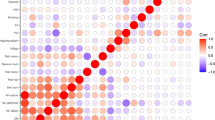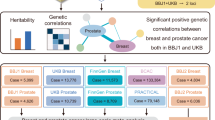Abstract
Linkage analysis and haplotype mapping in interspecific mouse crosses (Mus musculus × Mus spretus) identified the gene encoding Aurora2 (Stk6 in mouse and STK15 in human) as a candidate skin tumor susceptibility gene. The Stk6 allele inherited from the susceptible M. musculus parent was overexpressed in normal cells and preferentially amplified in tumor cells from F1 hybrid mice. We identified a common genetic variant in STK15 (resulting in the amino acid substitution F31I) that is preferentially amplified and associated with the degree of aneuploidy in human colon tumors. The Ile31 variant transforms rat1 cells more potently than the more common Phe31 variant. The E2 ubiquitin-conjugating enzyme UBE2N was a preferential binding partner of the 'weak' STK15 Phe31 variant form in yeast two-hybrid screens and in human cells. This interaction results in colocalization of UBE2N with STK15 at the centrosomes during mitosis. These results are consistent with an important role for the Ile31 variant of STK15 in human cancer susceptibility.
This is a preview of subscription content, access via your institution
Access options
Subscribe to this journal
Receive 12 print issues and online access
$209.00 per year
only $17.42 per issue
Buy this article
- Purchase on Springer Link
- Instant access to full article PDF
Prices may be subject to local taxes which are calculated during checkout







Similar content being viewed by others
References
Balmain, A., Ponder, B.A.J. & Gray, J. The genetics and genomics of cancer. Nat. Genet. 33, 238–244 (2003).
Ponder, B.A. Cancer genetics. Nature 411, 336–341 (2001).
Fijneman, R.J., de Vries, S.S., Jansen, R.C. & Demant, P. Complex interactions of new quantitative trait loci, Sluc1, Sluc2, Sluc3, and Sluc4, that influence the susceptibility to lung cancer in the mouse. Nat. Genet. 14, 465–467 (1996).
Balmain, A. & Nagase, H. Cancer resistance genes in mice: models for the study of tumour modifiers. Trends Genet. 14, 139–144 (1998).
Dietrich, W.F. et al. Genetic identification of Mom-1, a major modifier locus affecting Min-induced intestinal neoplasia in the mouse. Cell 75, 631–639 (1993).
Nagase, H. et al. Distinct genetic loci control development of benign and malignant skin tumours in mice. Nat. Genet. 10, 424–429 (1995).
Cormier, R.T. et al. The Mom1AKR intestinal tumor resistance region consists of Pla2g2a and a locus distal to D4Mit64. Oncogene 19, 3182–3192 (2000).
Nagase, H., Mao, J.H. & Balmain, A. A subset of skin tumor modifier loci determines survival time of tumor-bearing mice. Proc. Natl. Acad. Sci. USA 96, 15032–15037 (1999).
Iwabuchi, H. et al. Genetic analysis of benign, low-grade, and high-grade ovarian tumors. Cancer Res. 55, 6172–6180 (1995).
Kallioniemi, A. et al. Detection and mapping of amplified DNA sequences in breast cancer by comparative genomic hybridization. Proc. Natl. Acad. Sci. USA 91, 2156–2160 (1994).
Korn, W.M. et al. Chromosome arm 20q gains and other genomic alterations in colorectal cancer metastatic to liver, as analyzed by comparative genomic hybridization and fluorescence in situ hybridization. Genes Chromosomes Cancer 25, 82–90 (1999).
Tanner, M.M. et al. Frequent amplification of chromosomal region 20q12–q13 in ovarian cancer. Clin. Cancer Res. 6, 1833–1839 (2000).
Collins, C. et al. Positional cloning of ZNF217 and NABC1: genes amplified at 20q13.2 and overexpressed in breast carcinoma. Proc. Natl. Acad. Sci. USA 95, 8703–8708 (1998).
Albertson, D.G. et al. Quantitative mapping of amplicon structure by array CGH identifies CYP24 as a candidate oncogene. Nat. Genet. 25, 144–146 (2000).
Bischoff, J.R. et al. A homologue of Drosophila aurora kinase is oncogenic and amplified in human colorectal cancers. EMBO J. 17, 3052–3065 (1998).
Zhou, H. et al. Tumour amplified kinase STK15/BTAK induces centrosome amplification, aneuploidy and transformation. Nat. Genet. 20, 189–193 (1998).
Sen, S., Zhou, H. & White, R.A. A putative serine/threonine kinase encoding gene BTAK on chromosome 20q13 is amplified and overexpressed in human breast cancer cell lines. Oncogene 14, 2195–2200 (1997).
Cardon, L.R. & Bell, J.I. Association study designs for complex diseases. Nat. Rev. Genet. 2, 91–99 (2001).
Berry, R. et al. Evidence for a prostate cancer-susceptibility locus on chromosome 20. Am. J. Hum. Genet. 67, 82–91 (2000).
Dahlman, I. et al. Parameters for reliable results in genetic association studies in common disease. Nat. Genet. 30, 149–150 (2002).
Reich, D.E. et al. Linkage disequilibrium in the human genome. Nature 411, 199–204 (2001).
Bischoff, J.R. & Plowman, G.D. The Aurora/Ipl1p kinase family: regulators of chromosome segregation and cytokinesis. Trends Cell Biol. 9, 454–459 (1999).
Nigg, E.A. Centrosome aberrations: cause or consequence of cancer progression? Nat. Rev. Cancer 2, 815–825 (2002).
Lengauer, C., Kinzler, K.W. & Vogelstein, B. Genetic instability in colorectal cancers. Nature 386, 623–627 (1997).
Giet, R. & Prigent, C. Aurora/IpI1p related kinases a new oncongenic family of mitotic serine threonine kinases. J. Cell Sci. 112, 3591–3601 (1999).
McKenna, S. et al. Noncovalent interaction between ubiquitin and the human DNA repair protein MMS2 is required for Ubc13-mediated polyubiquitination. J. Biol. Chem. 276, 40120–40126 (2001).
Antoch, M.P. et al. Functional identification of the mouse circadian Clock gene by transgenic BAC rescue. Cell 89, 655–667 (1997).
Miyoshi, Y., Iwao, K., Egawa, C. & Noguchi, S. Association of centrosomal kinase STK15/BTAK mRNA expression with chromosomal instability in human breast cancers. Int. J. Cancer 92, 370–373 (2001).
Romanov, S.R. et al. Normal human mammary epithelial cells spontaneously escape senescence and acquire genomic changes. Nature 409, 633–637 (2001).
Aldaz, C.M., Trono, D., Larcher, F., Slaga, T.J. & Conti, C.J. Sequential trisomization of chromosomes 6 and 7 in mouse skin premalignant lesions. Mol. Carcinog. 2, 22–26 (1989).
Kemp, C.J., Fee, F. & Balmain, A. Allelotype analysis of mouse skin tumors using polymorphic microsatellites: sequential genetic alterations on chromosomes 6, 7, and 11. Cancer Res. 53, 6022–6027 (1993).
Hershko, A. & Ciechanover, A. The ubiquitin system. Annu. Rev. Biochem. 67, 425–479 (1998).
Meraldi, P., Honda, R. & Nigg, E.A. Aurora-A overexpression reveals tetraploidization as a major route to centrosome amplification in p53−/− cells. EMBO J. 21, 483–492 (2002).
Ruivenkamp, C.A. et al. Ptprj is a candidate for the mouse colon cancer susceptibility locus Scc1 and is frequently deleted in human cancers. Nat. Genet. 31, 295–300 (2002).
International Human Genome Sequencing Consortium. Initial sequencing and analysis of the human genome. Nature 409, 860–921 (2001).
Snijders, A.M. et al. Assembly of microarrays for genome-wide measurement of DNA copy number. Nat. Genet. 29, 263–264 (2001).
Segraves, R., Albertson, D. & Pinkel, D. Comparative genomic hybridization using BAC genomic microarrays. in DNA Arrays: A Laboratory Manual (ed. Bowtell, D.A.S.J.) 380–385 (Cold Spring Harbor Laboratory Press, New York, 2002).
Pinkel, D.E.A. High resolution analysis of DNA copy number variation using comparative genomic hybridization to microarrays. Nat. Genet. 20, 207–211 (1998).
Jain, A.N. et al. Fully automatic quantification of microarray image data. Genome Res. 12, 325–332 (2002).
Acknowledgements
We thank C. Collins and S. Volik for sharing unpublished data on mouse chromosome 2, D. Albertson and D. Pinkel for assistance with array CGH analysis, D. Albertson for help in interpretation of CGH arrays, R. del Rosario and R. Contreras for assistance with animal husbandry, the UCSF Cancer Center Genome Core for the sequencing and study design of allelic discrimination and A.H. Trainer for ascertainment of the paired colon samples for this study. S.L. thanks A. Ashworth, P. Workman and colleagues in the laboratory for discussions and support, M. Lelekakis for help in animal studies and D. Robertson for assistance with confocal microscopy. The UCSF School of Medicine Research Evaluation and Allocation Committee Fund, a US National Cancer Institute Mouse Models of Human Cancer Consortium Grant, the Stewart Trust, the UCSF Prostate Spore and a UCSF Prostate Cancer Center Award supported this work. J.P.d.K. was supported by a research fellowship through the Dutch Cancer Society. A.E.-T. was supported by a US National Institutes of Health training grant. B.A.J.P. is a Gibb Fellow of the Cancer Research UK. Studies carried out in S.L.'s laboratory were funded by the Breakthrough Breast Cancer Fund.
Author information
Authors and Affiliations
Corresponding authors
Ethics declarations
Competing interests
The authors declare no competing financial interests.
Rights and permissions
About this article
Cite this article
Ewart-Toland, A., Briassouli, P., de Koning, J. et al. Identification of Stk6/STK15 as a candidate low-penetrance tumor-susceptibility gene in mouse and human. Nat Genet 34, 403–412 (2003). https://doi.org/10.1038/ng1220
Received:
Accepted:
Published:
Issue Date:
DOI: https://doi.org/10.1038/ng1220
This article is cited by
-
Aurora kinase genetic polymorphisms: an association study in Down syndrome and spontaneous abortion
Human Cell (2022)
-
Nuclear localisation of Aurora-A: its regulation and significance for Aurora-A functions in cancer
Oncogene (2021)
-
Rebelled epigenome: histone H3S10 phosphorylation and H3S10 kinases in cancer biology and therapy
Clinical Epigenetics (2020)
-
The parathyroid hormone regulates skin tumour susceptibility in mice
Scientific Reports (2017)
-
Aurora Kinase A expression predicts platinum-resistance and adverse outcome in high-grade serous ovarian carcinoma patients
Journal of Ovarian Research (2016)



